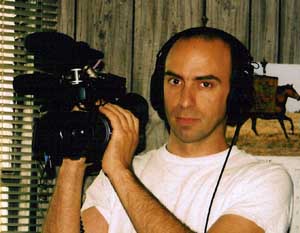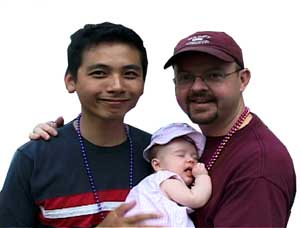-
- FMA fails in the House
- SLDN announces new legal challenge to ‘Don’t Ask, Don’t Tell’
- GLBTs more at ease in workplace
- The science of sex and God – it’s in the genes
- Conservative Mass. House picks social liberal before same-sex marriage fight
- Attorney general: Marriage amendment would harm economy
- National News Briefs
- World News Briefs
Arts & Entertainment
‘Tying the Knot’
Published Thursday, 07-Oct-2004 in issue 876
Director Jim De Seve knows that people in same-sex relationships will be fascinated by his new documentary, but they’re not necessarily the ones he wants to show it to.
It’s the folks at the Angus Cow Association in Oklahoma who really need to see it, says De Seve of his documentary Tying the Knot, which opens at the Ken Cinema for a week on Friday, Oct. 8.
De Seve’s film is a historical, political and geographical tour on the issue of marriage, encompassing footage as far back as the 1970s and an army of sound bites powerful enough to blow away whatever it is you think you know about marriage.
We learn, for instance, that, far from being a new issue, GLBT activists have been campaigning for rights to marriage at least since a 1971 sit-in protest at the New York City clerk’s office, and it’s footage of this protest that opens Tying the Knot. We also learn that the 1,138 federal rights denied to same-sex relationships affect the lives of many GLBT couples, two of which are documented close-up. And we learn from Dutch legal commentator Kees Waaldijk that, far from being a static tradition, the institution of marriage has already incorporated a handful of cultural changes just as dramatic as that presented by same-sex couples – particularly changes in divorce laws, the legal rights of women and miscegenation laws, all of which have provided opportunities for the institution of marriage to change with the times. Marriage, says Waaldijk, has become a stronger institution by doing so.
In 82 minutes of digital video, Tying the Knot features the voices of Congress members, sociologists, historians and raging activists on both sides of the same-sex marriage issue, and we see how the debate plays out in the Netherlands, Canada, Tampa, Fla., and rural Oklahoma.
But amidst all of the talking heads, the theories and the impassioned arguments from people like Focus on the Family’s James Dobson on one side and the Metropolitan Community Church’s Rev. Tony Perry on the other, it’s two moving stories from real-life relationships in the heart of America that argue most eloquently for marriage equality, and elevate de Seve’s effort above the average political documentary.
Take the story of Sam, a rancher in rural Oklahoma. We find him just before he’s forced to give up the ranch that he’s lived on, raised three children on and worked on with Earl, his late partner of 22 years. When Earl dies, some cousins contest his will and win the ranch from Sam on a legal technicality. (Earl’s will required a missing third signature.)
Sam is not your typical Queer-Eye-for-the-Straight-Guy gay. He’s a real-life rancher who is first introduced to the audience hanging around with a group of male ranchers, talking about marriage. Later, we find Sam sitting and contemplating the love of his life who has recently died, Earl.
Sam’s honest, straightforward reflections on marriage open the eyes to a simple yet remarkable fact: Same-sex relationships, it seems, are no different than the other kind. When Sam, who was also married to a woman, is asked what differences there are in being married to a woman or a man, he pauses before letting out a “hmmmph” and drawling in an Oklahoma accent, “Other than sex, not one damn thing.”
De Seve and his camera become privy to the final attempts by this broken, stoic rancher to salvage what’s left of his property as the eviction notices from Earl’s cousins force him from his home. And we viewers get ring-side seats to a heartbreaking process as Sam is forced to sell his horses and go to his own relatives for loans.
It’s stories like Sam’s, says De Seve, that will convince the unconvinced of the inequities in America’s marriage laws.
And that’s where the Angus Cow Association comes in.
“I want to be able to take this back to the Angus Cow Association meeting in Oklahoma, and to labor unions and to PTAs,” says De Seve, “and anywhere where we can reach out to reasonably minded people who just need to have these stories shown [to them].”
De Seve began his documentary project about four years ago, he explained in a recent phone conversation with the Gay & Lesbian Times, “and it really wasn’t a big issue at that time.” For drama, De Seve left the United States in favor of the Netherlands, where same-sex marriages were made legal in 2001 with 85- percent public approval.
“We went off to Holland,” says De Seve, “and we started meeting some of these couples that had gotten married and that was just eye opening … ‘What are some of the problems?’ [we asked them] and they sort of looked at me like I was crazy. … One of them tilted his head, like, ‘Problems?’ That made me wonder, how does one society come to accept same-sex couples?”
De Seve’s wondering took him from casual conversations in Amersterdam apartments to intense interviews with European and American sociologists, most notably gay sociologist EJ Graff, who wrote What is Marriage For? and who is featured throughout the documentary.
All of this background, says De Seve, provided a “glimpse of Christmas yet to come” in America, he says. And when he returned to the states, De Seve and his production team were surprised to find that Christmas was coming sooner than they had imagined; current events began unfolding before their cameras with the November, 2003, Massachusetts Supreme Court ruling allowing same-sex marriages in the state, and the sudden release of marriage certificates to same-sex couples in San Francisco, followed by vociferous statements about “protecting marriage” from President Bush.
The unfolding events provided a logistical challenge to De Seve and his team, which were left with 400 hours of footage and no idea when to stop taping.
“As we were editing, things kept changing,” he says, “… It became really difficult because things were just changing so quickly.” The team finally decided to end at the beginning, and wrapped up taping in Massachusetts, saying, ‘OK. The floodgates have opened.’”
The result is a documentary that begins with a quiet unfolding of historical footage, sociological context and real-life stories like Sam’s, then crescendos into a cacophony of political and activist voices. One heartbreaking moment amid the frenzy is when a little girl no older than 10 shouts from a group of conservative protestors to the camera, “Hey, hey, ho, ho, homosexuals gotta go”. Another equally moving moment comes from African-American U.S. Rep. Charles Lewis, who grew up amidst segregation laws in the South and is seen asking his fellow members of Congress, “Why do you want to crush their hopes, their dreams, their longings, their aspirations? We are talking about human beings, people like you, people who want to get married, buy a house, and spend their lives with the one they love.” All of this noise culminates in a dramatic, candlelit party of same-sex couples and activists in Massachusetts celebrating their new equal marriage rights at the close of midnight last May 17.
But in spite of the far-reaching footage and political breadth this documentary delivers, when De Seve discusses what he hopes viewers get from his film he brings it all back home to the personal stories: “I want to share my discovery of marriage with my audience,” De Seve writes in the film’s press notes. “… I hope [these] inspiring stories, despite their heartbreaking losses, will lift us, especially in America, to be better people, tolerant and loving to others.”
|
|
Copyright © 2003-2025 Uptown Publications




